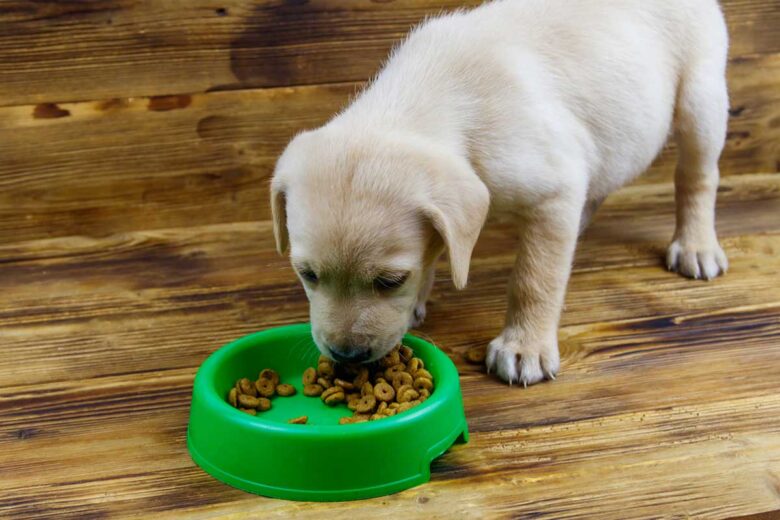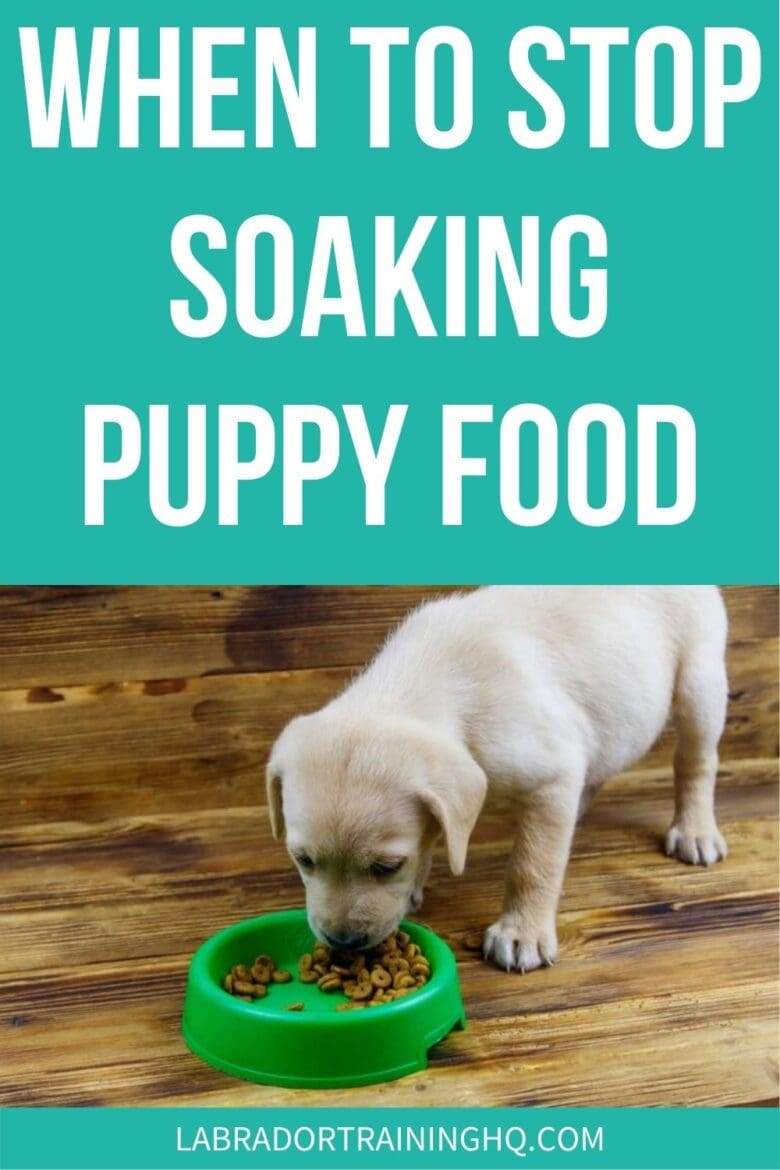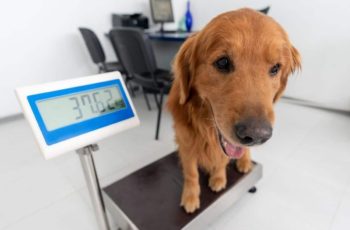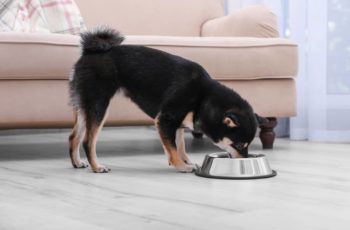This post may contain affiliate links. We may earn money or products from the companies mentioned in this post.
If you’re raising puppies, it’s important to know when to wean them off their mother’s milk, how to soak their kibble, and when to stop soaking your puppy’s food to best support their growing bodies.
Puppies’ bodies change rapidly when they are small and so do their dietary needs.
When they are very little and being weaned off their mother’s milk, they need their solid food to be softened in some water to make it easier to eat.
However, after a couple of weeks, their teeth will be coming in and they’ll need solid food to help them teethe properly.

As your puppy grows older, that dry food actually acts as a teeth cleaner as it scrapes plaque buildup.
Read on to find out the whys and hows of soaking your puppy’s food and when you should stop.
Contents & Quick Navigation
Why Soak Puppy Food
Puppies start to be weaned at three to four weeks of age. During this time, they are still very small, lack coordination, and their teeth may not be making an appearance just yet.
This is why their puppy kibble needs to be soaked. The soaked puppy food is referred to as a puppy gruel and is actually more water than kibble.
This helps to hydrate your puppy with some yummy-tasting water as they are no longer getting the hydration they need from their mother’s milk.
Soaking the kibble makes it easy for your puppy to lap up as they cannot chew just yet.
It is ideal to serve the puppy gruel in a flat dish that cannot be tipped over, because puppies will make a mess and flip the bowl over if they can.
How To Soften Puppy Food
To soften your puppy’s kibble, take the appropriate amount of food and place it in their clean, dry bowl. Then take just-boiled water and pour it over the kibble enough to cover it.
Give the water and kibble mixture a stir and let it sit for at least five minutes.
After five to 10 minutes, the kibble should be soft and the mixture at room temperature.
If it’s still too hot, pop it in the refrigerator for a couple of minutes to bring it to room temperature. Do not reheat the mixture in the microwave or on the stove if it gets too cold.
Reheating the gruel removes most of the nutrients your puppy needs.
When the mixture is at room temperature, serve it to your puppy.
Over the next two weeks, use less water and more kibble to slowly transition your puppy from gruel to solid food.
Each meal should be soaked right before it’s served. You cannot pre-soak your puppy’s kibble for the day or the week.
For more information on how often to feed your puppy, check out our dedicated article.
When To Stop Soaking Puppy Food
Your puppy’s teeth should start coming in at between five and six weeks of age. They now no longer need the puppy kibble to be soaked in order to eat it and they can manage solid food now.
By eight weeks old, they should be completely off the puppy gruel and only getting solid kibble.
If you have adopted or bought your puppy from a reputable breeder or shelter, this is the age at which you will bring your puppy home and you should not need to worry about when to stop soaking their food as you should only be giving them solid kibble by now.
For some very small breeds whose jaws and teeth develop more slowly or for ‘late-blooming’ puppies, they may need their food soaked for another week or two but should definitely not need their food soaked beyond 10 weeks.
Why Should You Stop Soaking Your Puppy’s Food?
Once your puppy’s teeth start to come in, they need to chew on things to help them teethe. The easiest way to help them do this is to use solid food.
The solid food will press against their gums and help them teethe naturally.
Helping them teethe using solid food will also reduce the amount of chewing they do on furniture and shoes!
Additionally, solid food scrapes the teeth. This is important because it removes any plaque that is building up, keeping their teeth and gums healthy and fresh.
Does Soaking Your Puppy’s Food Help With Digestion?
Your puppy’s body naturally produces stomach acid, which is required to break down their food to digest all of the components and absorb them properly. Water does not aid that process.
However, if your puppy is very young and struggles with the mechanical part of the digestion process (the chewing), then adding water to their food will help them break it down and prepare it for the chemical part of digestion.
Having water at the same time as food does not affect the rate of digestion or the rate of absorption.
Therefore, having food with the water does not necessarily help with digestion provided your pup is properly hydrated.
Does Soaking Your Puppy’s Food Help With Hydration?
Dogs are prone to dehydration as they tend to forget to drink. Mixing water into their food helps to keep them hydrated as they have no choice but to lap up the water as they eat.
Puppies benefit from having their kibble soaked in water because they have been used to getting their hydration and nutrition from their mother’s milk.
It is important to provide your puppy with access to fresh, clean water at all times even if they do not appear to be drinking it.
As you decrease the amount of water in their puppy gruel, they will seek out other sources of water and start to drink from their water bowl.
FAQs About Soaking Puppy Food
My puppy’s kibble expands so much when I soak it, does it do the same in their stomachs? Will it cause bloat?
When soaking your puppy’s kibble, you will see the pellets expand a lot. This may be fairly alarming if you think the pellets are going to expand the same way inside your puppy’s stomach.
Do not worry. Your puppy’s kibble will not react with their stomach acid in the same way it reacts with the water. Therefore, it will not expand in the same way.
Additionally, your puppy’s stomach will be actively breaking the kibble down and passing it through to the small intestines to start the process of absorption.
This means they kibble does not have enough time to expand in your puppy’s stomach even if it could.
You do not need to worry about your puppy developing bloat because of kibble expanding.
Bloat happens when your dog takes too much air into their stomachs when they are eating. If you are worried about bloat, use a slow feeder to slow your puppy down.
What are some things you should never do when soaking your puppy’s food?
Soaking your puppy’s food is not as easy as it sounds and there are some things that you can do wrong that will affect your puppy negatively. Those include:
Serving it boiling hot
As mentioned, you need to soak the kibble in just-boiled water for it to soften up properly. If you are in a rush, you may put the food down while it is still very hot and think, “My puppy is smart enough to wait, right?”
Unfortunately, puppies are not smart enough to wait and they will try to eat the very hot food.
They will burn their mouths, or possibly and more dangerously, they will eat the hot food and alter their internal body temperature.
Their bodies are very little that a big temperature change can have nasty side effects that require veterinary help.
Leaving it out for too long
Solid dog food (kibble) contains meat products in it. Once this meat comes into contact with water, it will start to ferment within 20 minutes.
If the food is left out for longer, the fermentation will start and your puppy will be eating rotting food.
Warm, mushy food is the ultimate breeding ground for bacteria. This will usually result in your puppy getting an infection and they will have very loose, smelly stools, which will lead to dehydration.
After about 20 minutes, remove any food that is left over and throw it away. If your puppy has not had enough to eat, they will supplement with water or be more eager for their next feeding time.
Not cleaning the dish properly
Simply rinsing out their food bowl is not enough, especially when they are getting soaked kibble. It is essential to wash your puppy’s food dishes in hot, soapy water to remove any and all traces of meat and fat to prevent bacteria buildup.
Once you have washed the dish in hot, soapy water, it is important to rinse it thoroughly in clean water to rinse off all chemicals and products that may make your puppy sick.
What kind of food do puppies need as they grow?
Dogs need different kinds of food as they age because they have different nutritional requirements.
One month old
From birth, your puppy will be drinking from its mother. This milk is essential for their development and physical and mental growth, as well as their immune system.
If your puppy is in the unfortunate circumstance where it does not have a mother, then they can be bottle fed using special puppy milk. To find out how to bottle feed your puppy, check out our dedicated article.
From about three to four weeks old, your puppy can start transitioning to kibble that is soaked.
The kibble will provide a more diverse range of nutrients for your puppy as the process of weaning them off their mother’s milk takes place.
Two to four months old
Between two and four months, your puppy needs a high-calcium diet as they are busy building their bones. It is important to check their food, as well as any supplements you add, to ensure it has a low phosphorus ratio.
Ideally, the calcium-to-phosphorus ratio should be 3:1 as phosphorus binds to calcium and prevent your puppy’s body from absorbing it.
Four to seven months old
Between four and seven months, your puppy will be bulking out its body and becoming the size it will be as an adult.
Their diet should be high in protein that is easily digestible. The protein will help them build important muscle attachments and grow their brains.
10 months+
From 10 months onward, your puppy’s dietary needs will broaden to include vitamins and minerals and additional supplements depending on their breed needs.
For example, a breed that suffers from joint issues should have a joint supplement added to their food.
Barking Off: When To Stop Soaking Puppy Food
If you have adopted or bought a puppy from a reputable shelter or breeder, you should not have to worry about when to stop soaking your puppy’s food as they should already be on a solid diet.
However, if you find yourself in the situation where you are taking care of very young puppies, then you definitely need all the information on soaking.
You should start your puppy on a soaked kibble diet at about four weeks old. Over the next month, reduce the amount of water you add to the kibble to help them transition to the solid diet.
By eight to 10 weeks, you should have stopped soaking your puppy’s food altogether and they should only be eating solid kibble and drinking water on their own.
Save To Pinterest

Top Picks For Our Dogs
- BEST PUPPY TOY
We Like: Calmeroos Puppy Toy w/ Heartbeat and Heat Packs – Perfect for new puppies. Helps ease anxiety in their new home. - BEST DOG CHEW
We Like: Bones & Chews Bully Sticks – All of our puppies love to bite, nip, and chew. We love using Bully Sticks to help divert these unwanted behaviors. - BEST DOG TREATS
We Like: Crazy Dog Train Me Treats – One of our favorite treats for training our service dog puppies. - BEST FRESH DOG FOOD
We Like: The Farmer’s Dog – A couple months ago we started feeding Raven fresh dog food and she loves it! Get 50% off your first order of The Farmer’s Dog.
For a list of all the supplies we get for our new service dog puppies check out our New Puppy Checklist on the PuppyInTraining.com blog.
When To Stop Soaking Puppy Food (When, Why, How) was last modified: December 16th, 2022 by


